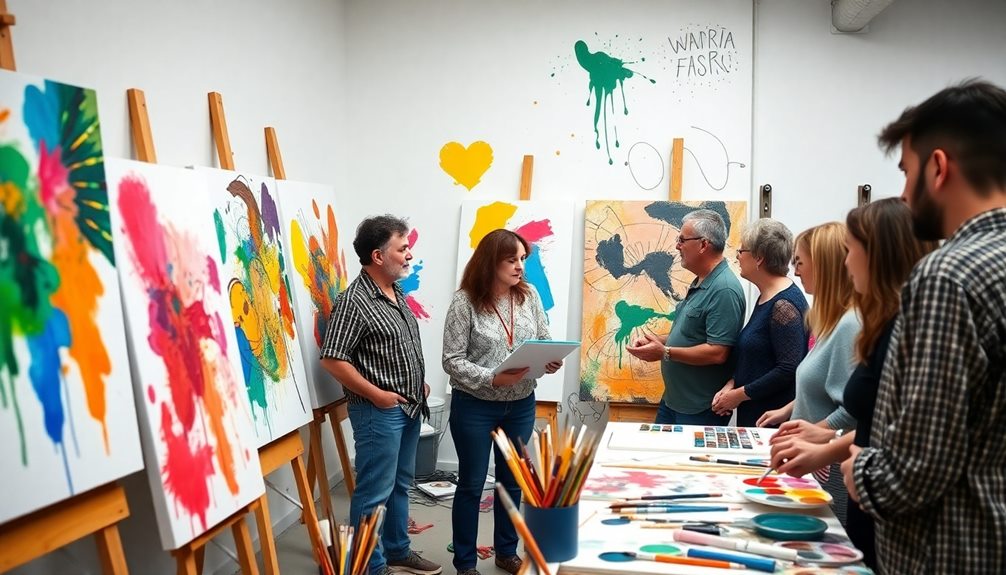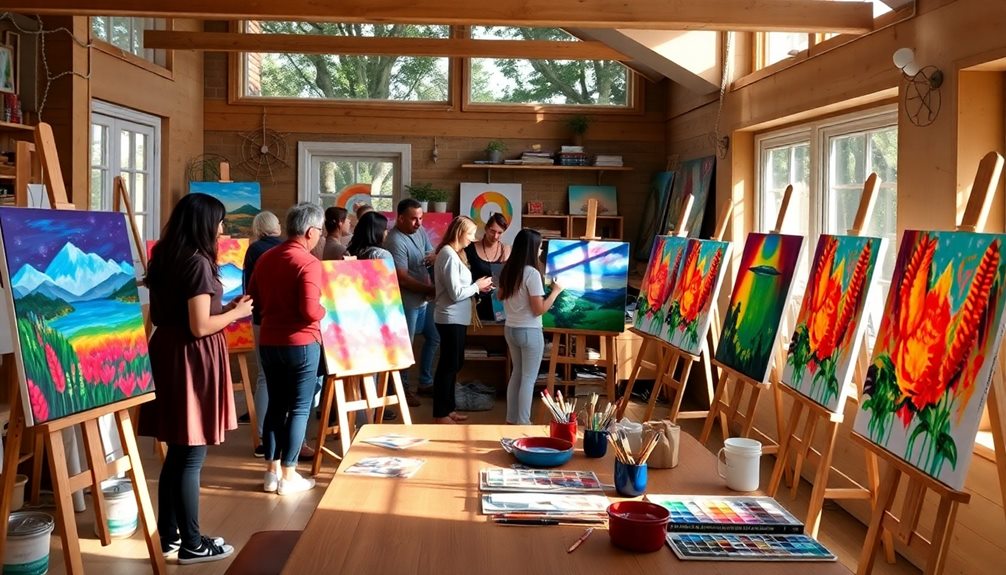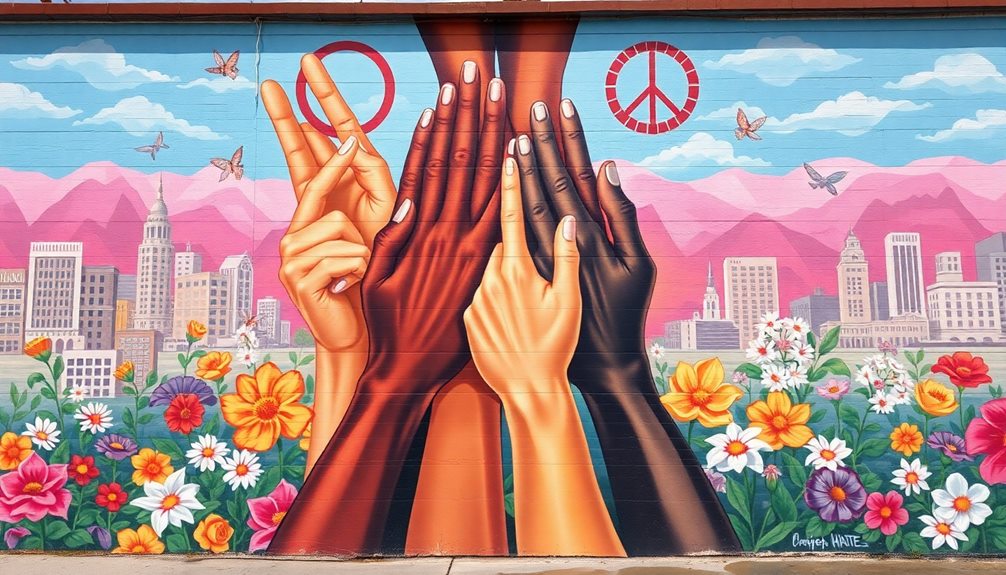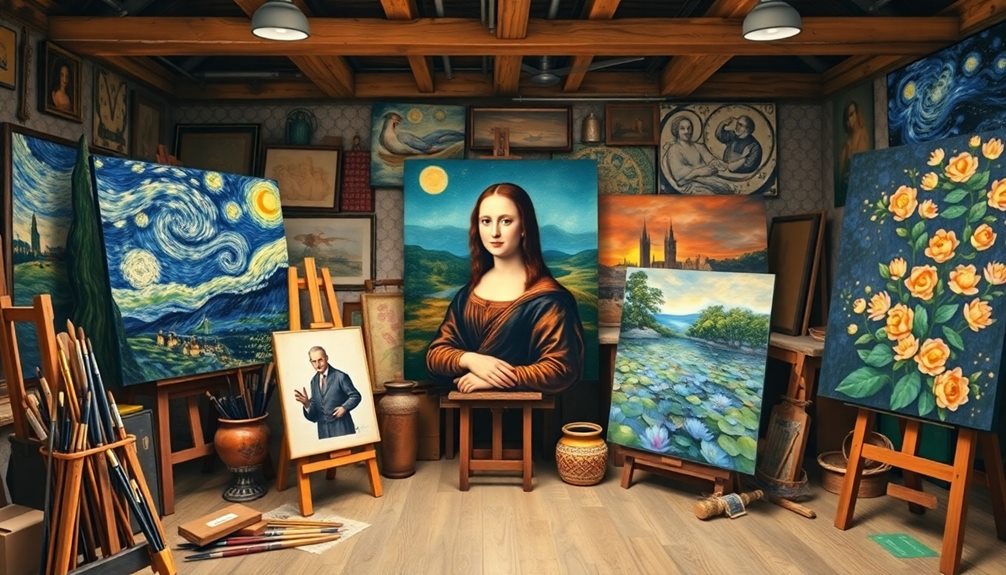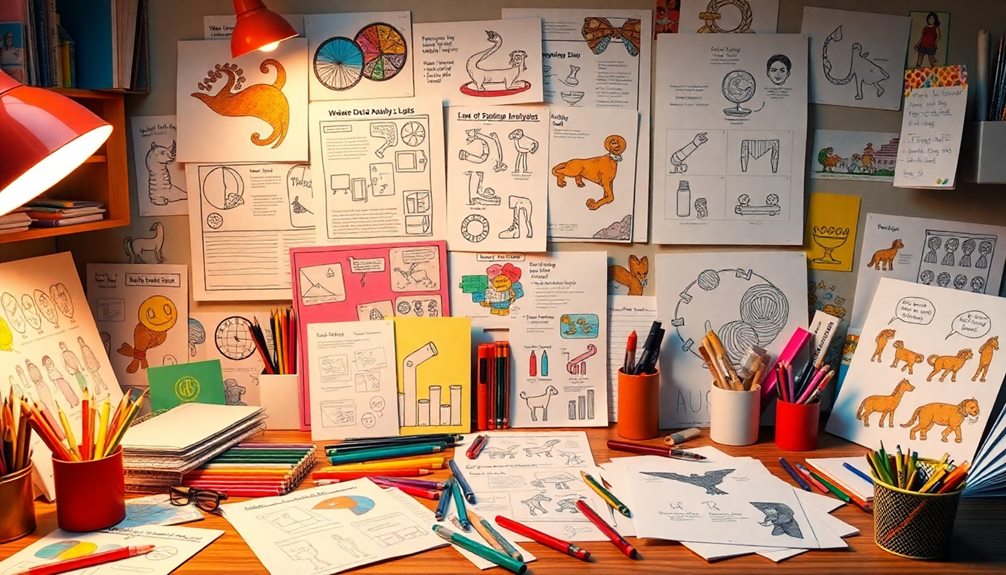Engaging with art helps you sharpen your critical thinking skills. When you analyze complex artworks, you learn to interpret and assess visual information more deeply. This process encourages you to question assumptions and enhances your problem-solving abilities. Participation in art projects also fosters creativity and collaboration, allowing you to explore diverse perspectives and narratives. Additionally, research shows that students involved in arts education tend to achieve higher test scores and graduation rates. By integrating art into learning, you can boost your analytical skills and engage with real-world issues in meaningful ways. Discover more about the transformative power of art.
Key Takeaways
- Art education enhances critical thinking by encouraging close observation and analysis of complex visual contexts.
- Engaging with diverse artworks fosters empathy and promotes nuanced understanding of various cultural perspectives.
- Collaborative art projects strengthen communication skills and cooperative reasoning among peers.
- Art integration in education boosts problem-solving abilities and encourages innovative thinking across disciplines.
- Artistic expression serves as a medium for emotional conveyance and enhances self-reflection, contributing to overall mental well-being.
Importance of Art in Education
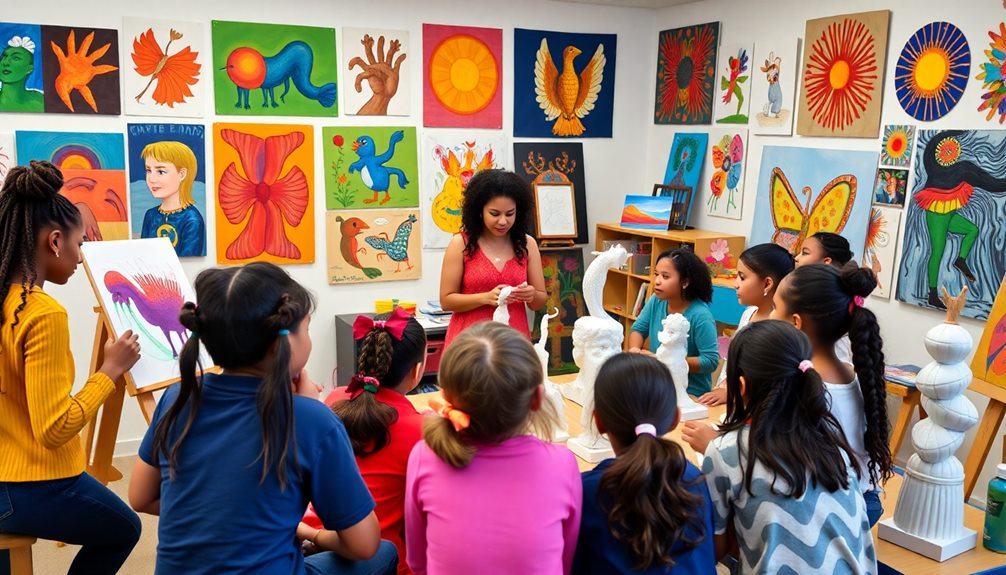
Art education is an essential pillar in shaping well-rounded individuals. When you engage in arts education, you're not just creating; you're also developing indispensable skills like critical thinking. This process encourages you to observe the world around you and analyze the complexities of everyday life. As you explore different artistic mediums, you learn to interpret various perspectives, enhancing your ability to empathize with others.
Research shows that students involved in arts education often achieve higher test scores and graduation rates. This connection highlights the importance of integrating art into the curriculum, as it balances analytical and creative skills necessary for tackling modern challenges. By nurturing these abilities, you're preparing yourself for a future where innovative solutions are crucial.
Moreover, arts education can combat budget cuts that threaten creative programs in schools. By advocating for these programs, you're ensuring that future generations can experience the benefits of a well-rounded education.
Ultimately, the importance of art in education extends beyond the classroom, fostering a more inclusive society where you can thrive personally and academically. Embrace the power of art, and watch how it transforms your understanding of the world.
Understanding Critical Thinking
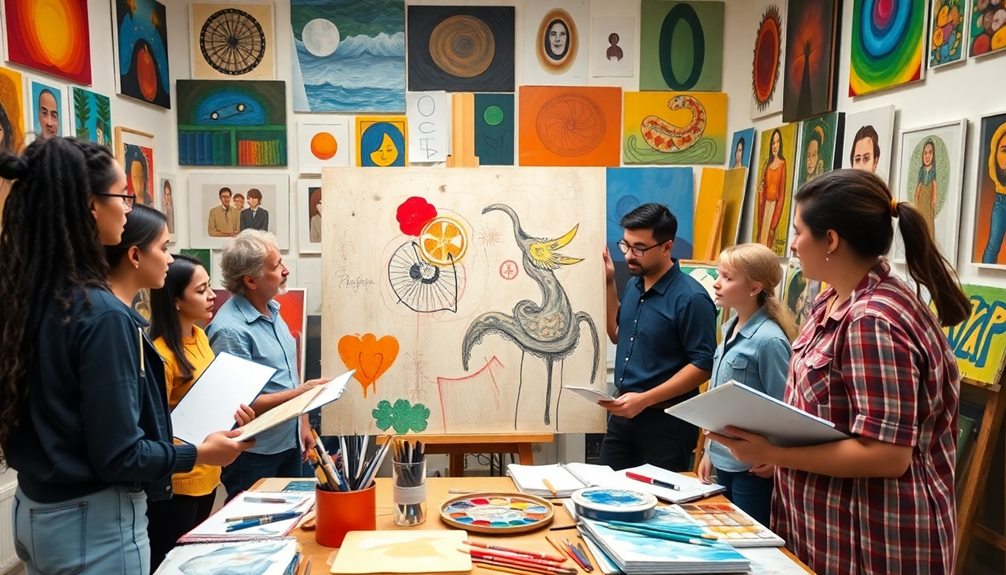
Critical thinking skills are essential for traversing the complexities of today's world, especially in education.
These skills allow individuals to assess information critically and develop a deeper understanding of various subjects, which is vital in a rapidly evolving society.
You need to question assumptions and analyze information to make informed decisions.
Defining Critical Thinking Skills
In today's fast-paced world, understanding critical thinking skills is more important than ever. These skills enable you to engage in reflective thought, allowing you to observe and analyze various situations critically. Instead of accepting ideas and assumptions at face value, critical thinkers question them, promoting a deeper understanding of complex issues.
When you prioritize obtaining thorough information, you equip yourself to make informed decisions across different contexts. This approach isn't just beneficial academically; it's essential for effective problem-solving in your professional life. Engaging in critical thinking fosters patience and careful consideration, qualities that help you navigate modern challenges more effectively.
Additionally, critical thinking encourages creative expression. By developing your ability to analyze and reflect, you can explore innovative solutions to problems that others might overlook.
Importance in Education
The development of critical thinking in education is essential for preparing students to navigate a complex world. In today's society, you're often faced with multifaceted issues that require you to analyze and evaluate different perspectives. Critical thinking skills empower you to question ideas and assumptions rather than accepting them at face value. This reflective approach is important for making informed decisions, whether in your career or personal life.
In addition, integrating technology, such as Intelligent Tutoring Systems (ITS), can provide personalized learning experiences that foster critical thinking.
Integrating visual arts into your education can greatly enhance these skills. When you engage with art, you're prompted to observe closely, analyze meaning, and interpret various viewpoints. This process encourages patience and careful consideration, essential traits for tackling complex problems.
Research shows that when you practice observation in art, you're not only appreciating beauty but also developing critical thinking competencies.
Art's Role in Critical Thinking
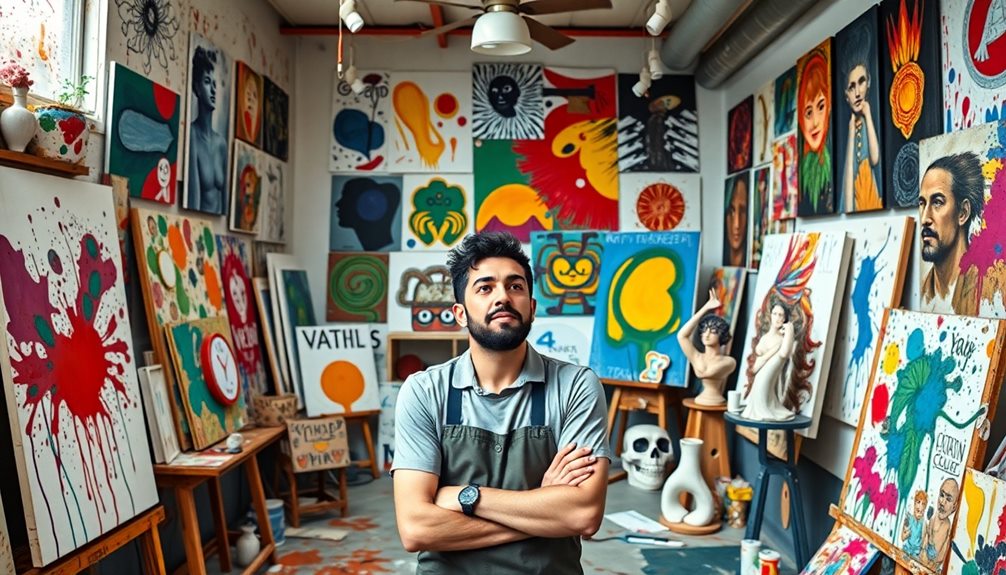
When you engage with complex artworks, you sharpen your analytical skills as you interpret various meanings.
This process not only enhances your ability to evaluate diverse perspectives but also challenges your initial reactions.
Art Encourages Analytical Skills
Engaging with art not only sparks creativity but also sharpens your analytical skills. When you immerse yourself in complex artworks, you learn to identify and interpret multiple meanings, enhancing your critical thinking abilities. This process isn't just about appreciation; it's also about evaluation.
As you create and critique art, you analyze your own work and that of others, which fosters a deeper understanding and critical evaluation of visual information.
Art education promotes close observation of the world around you, encouraging you to assess visual context critically. Research shows that students involved in art education exhibit improved analytical skills, essential for informed decision-making in various aspects of life.
When you tackle art projects, you often engage in problem-solving and iterative processes, honing your analytical skills that can be applied across different subjects and real-world scenarios.
Diverse Perspectives in Art
Art provides a unique lens through which you can explore diverse perspectives, enriching your critical thinking skills. Engaging with a variety of artistic expressions allows you to analyze and interpret multiple meanings. This not only enhances your observational skills but also fosters a deeper appreciation for different cultural viewpoints.
By confronting various artistic styles, you might find yourself questioning your own assumptions and broadening your understanding of complex issues.
Consider these benefits of exploring diverse perspectives in art:
- Empathy Development: Exposure to different narratives helps you cultivate empathy, making you more open-minded when evaluating complex societal challenges.
- Collaborative Learning: Working on group art projects encourages you to communicate and negotiate with others, strengthening your cooperative reasoning skills.
- Critical Reflection: Engaging with diverse works of art prompts you to reflect on your own viewpoints and encourages a more nuanced understanding of the world around you.
Research supports the idea that students who engage with diverse perspectives in art are better equipped to tackle challenges, making art an essential tool for enhancing critical thinking.
Benefits of Art Education
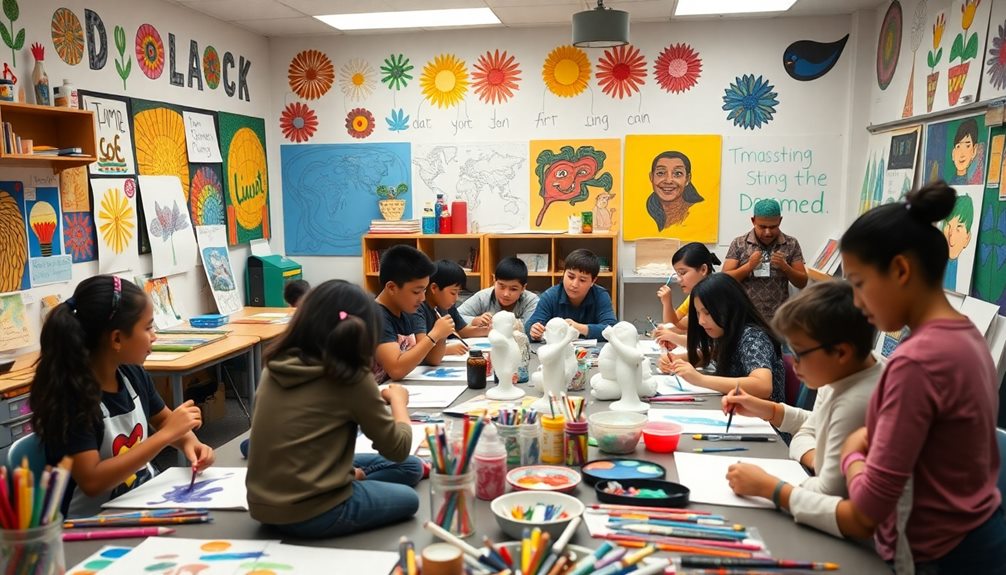
Through the lens of education, art education offers a multitude of benefits that extend beyond creativity. By engaging with complex artworks, you enhance your critical thinking skills, which leads to improved problem-solving abilities. When you analyze and interpret various artistic expressions, you learn to observe details that others might overlook, fostering a deeper understanding of both art and life.
This process of exploration can greatly contribute to the development of curiosity and happiness, as engaging with new experiences often leads to greater life satisfaction.
Studies show that students involved in art programs often achieve higher test scores and graduation rates. This indicates how arts education positively impacts overall academic performance.
Furthermore, exposure to diverse artistic perspectives cultivates empathy and tolerance, allowing you to appreciate different viewpoints and cultures.
Art education also promotes creativity, which can greatly enhance your learning outcomes in other subjects. By encouraging innovative thinking and exploration of ideas, you develop a more adaptable mindset.
Additionally, engaging in artistic activities boosts psychological resilience, helping you manage stress and develop effective coping strategies.
Ultimately, the benefits of art education are profound, equipping you with essential skills that transcend the classroom and enrich your personal and academic life.
Strategies for Arts Integration
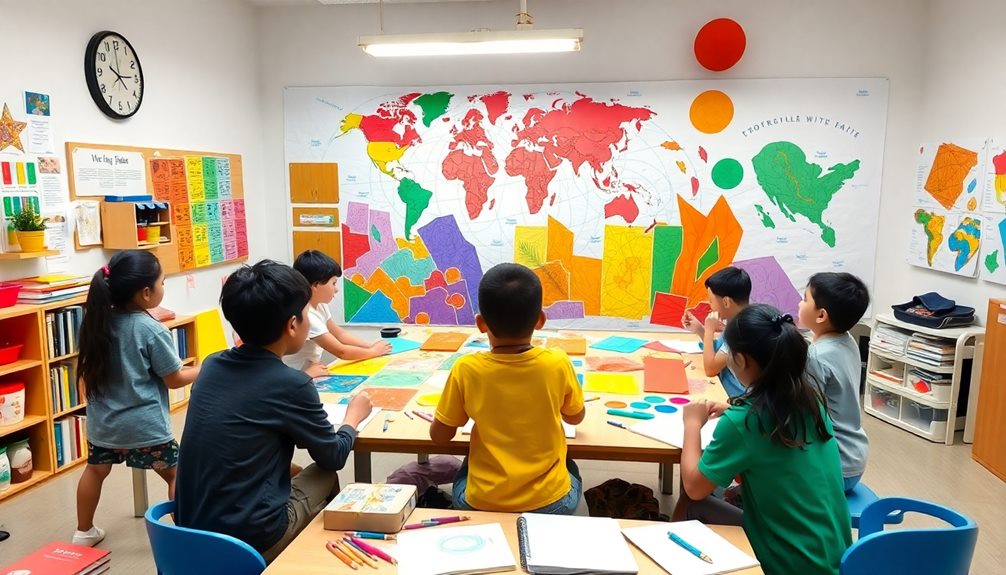
Creativity and innovation thrive when educators weave art into core subjects, transforming traditional learning environments. By using arts integration strategies, you can encourage your students to engage in observation and study, enhancing their understanding of complex concepts while fostering critical thinking and problem-solving skills.
Incorporating elements from supporting a partner ready for parenthood can also inspire collaboration and creativity among students as they learn to work together.
Consider these effective approaches:
- Combine Visual Arts and Science: Let students create visual representations of scientific concepts, deepening their analytical skills and understanding.
- Implement STEAM Education: Merge artistic creativity with technical disciplines, promoting innovative solutions that can arise from this cross-disciplinary approach.
- Engage in Collaborative Projects: Incorporate art into social studies by having students create multimedia presentations on political and social issues, encouraging critical engagement with real-world topics.
When you focus on arts integration, you not only enhance student learning outcomes but also improve their engagement in the classroom.
Professional development for educators in this area equips you with effective strategies to implement arts integration across various disciplines. By doing so, you empower your students to think critically and creatively, preparing them for the complexities of the world around them.
Art as a Tool for Expression
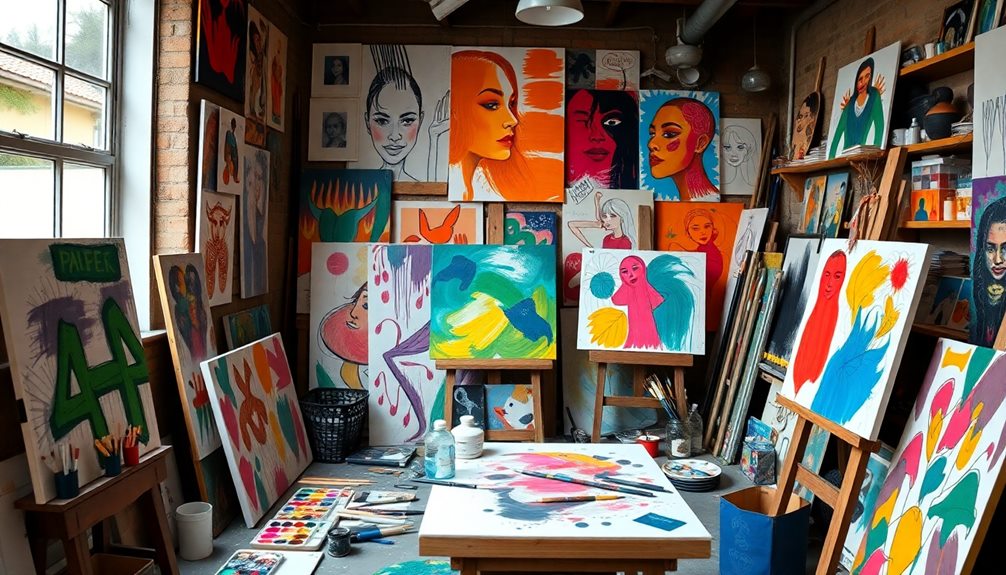
When students integrate art into their learning, they discover it's not just a subject but a powerful tool for personal expression. Artistic expression allows you to convey your emotions and experiences, creating a deeper connection with both yourself and the world around you. Engaging in art offers a safe outlet for self-expression, helping you process complex feelings and promoting mental well-being.
As you create art, you learn to articulate your thoughts and ideas, which enhances your communication skills and boosts your confidence. This process encourages you to observe diverse perspectives, cultivating empathy and fostering an understanding of different cultural narratives and social issues.
Moreover, art serves as a dynamic medium for activism, empowering you to raise awareness and provoke discussions on critical societal challenges. By exploring these themes through your work, you develop critical thinking skills that allow you to analyze and reflect on significant topics in society.
Ultimately, when you harness art as a means of expression, you not only enrich your own life but also contribute to a broader dialogue that can inspire change and understanding in your community.
Frequently Asked Questions
How Does Art Develop Critical Thinking Skills?
Art challenges you to interpret meanings, analyze details, and consider different perspectives. By creating and critiquing, you sharpen your problem-solving skills, fostering a mindset that values observation and thorough examination in any context.
What Are the 7 Steps to Thinking Critically About Art?
To think critically about art, start with observation, then analyze elements like composition. Next, interpret meaning, contextualize its background, and evaluate its impact. For example, consider how Van Gogh's "Starry Night" evokes emotion and movement.
How Does Creativity Help Critical Thinking?
Creativity sparks your critical thinking by encouraging you to explore diverse ideas and approaches. It helps you connect seemingly unrelated concepts, enhancing problem-solving skills and promoting a more open-minded perspective when evaluating information and making decisions.
How Do You Become Critical in Art?
To become critical in art, you need to observe closely, analyze various elements, and engage with diverse works. Experimenting with techniques and participating in discussions will sharpen your ability to articulate and defend your opinions.
Conclusion
In weaving art into education, you're not just adding color to the canvas of learning; you're crafting a masterpiece of critical thinking. Each brushstroke encourages you to question, analyze, and connect ideas in ways that textbooks can't. By embracing this creative journey, you reveal new perspectives and foster a deeper understanding of the world around you. So, immerse yourself in the vibrant domain of art, and watch your critical thinking skills blossom like a garden in spring.
